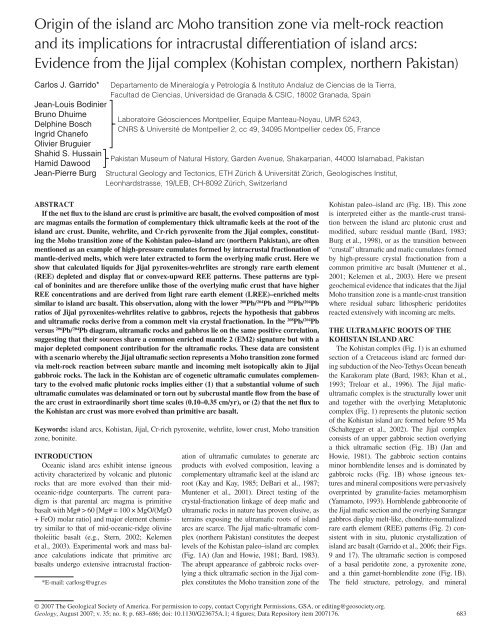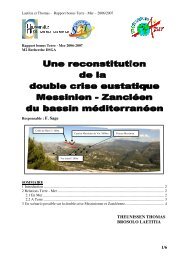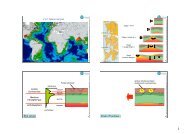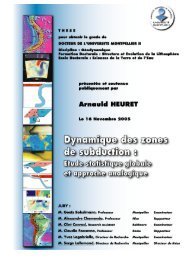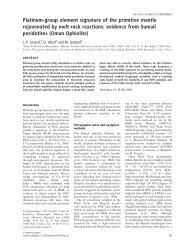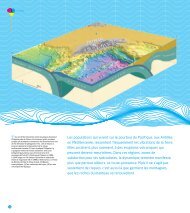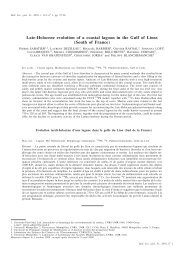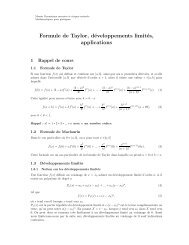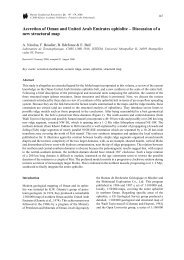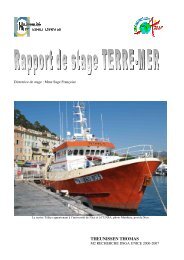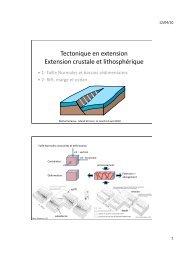Géochronologie U-Pb par ablation laser et ICP-MS (LA-ICP-MS ...
Géochronologie U-Pb par ablation laser et ICP-MS (LA-ICP-MS ...
Géochronologie U-Pb par ablation laser et ICP-MS (LA-ICP-MS ...
You also want an ePaper? Increase the reach of your titles
YUMPU automatically turns print PDFs into web optimized ePapers that Google loves.
Origin of the island arc Moho transition zone via melt-rock reaction<br />
and its implications for intracrustal differentiation of island arcs:<br />
Evidence from the Jijal complex (Kohistan complex, northern Pakistan)<br />
Carlos J. Garrido*<br />
Jean-Louis Bodinier<br />
Bruno Dhuime<br />
Delphine Bosch<br />
Ingrid Chanefo<br />
Olivier Bruguier<br />
Shahid S. Hussain<br />
Hamid Dawood<br />
Jean-Pierre Burg<br />
De<strong>par</strong>tamento de Mineralogía y P<strong>et</strong>rología & Instituto Andaluz de Ciencias de la Tierra,<br />
Facultad de Ciencias, Universidad de Granada & CSIC, 18002 Granada, Spain<br />
Laboratoire Géosciences Montpellier, Equipe Manteau-Noyau, UMR 5243,<br />
CNRS & Université de Montpellier 2, cc 49, 34095 Montpellier cedex 05, France<br />
Pakistan Museum of Natural History, Garden Avenue, Shakar<strong>par</strong>ian, 44000 Islamabad, Pakistan<br />
Structural Geology and Tectonics, ETH Zürich & Universität Zürich, Geologisches Institut,<br />
Leonhardstrasse, 19/LEB, CH-8092 Zürich, Switzerland<br />
ABSTRACT<br />
If the n<strong>et</strong> flux to the island arc crust is primitive arc basalt, the evolved composition of most<br />
arc magmas entails the formation of complementary thick ultramafic keels at the root of the<br />
island arc crust. Dunite, wehrlite, and Cr-rich pyroxenite from the Jijal complex, constituting<br />
the Moho transition zone of the Kohistan paleo–island arc (northern Pakistan), are often<br />
mentioned as an example of high-pressure cumulates formed by intracrustal fractionation of<br />
mantle-derived melts, which were later extracted to form the overlying mafic crust. Here we<br />
show that calculated liquids for Jijal pyroxenites-wehrlites are strongly rare earth element<br />
(REE) depl<strong>et</strong>ed and display flat or convex-upward REE patterns. These patterns are typical<br />
of boninites and are therefore unlike those of the overlying mafic crust that have higher<br />
REE concentrations and are derived from light rare earth element (LREE)–enriched melts<br />
similar to island arc basalt. This observation, along with the lower 208 <strong>Pb</strong>/ 204 <strong>Pb</strong> and 206 <strong>Pb</strong>/ 204 <strong>Pb</strong><br />
ratios of Jijal pyroxenites-wehrlites relative to gabbros, rejects the hypothesis that gabbros<br />
and ultramafic rocks derive from a common melt via crystal fractionation. In the 208 <strong>Pb</strong>/ 204 <strong>Pb</strong><br />
versus 206 <strong>Pb</strong>/ 204 <strong>Pb</strong> diagram, ultramafic rocks and gabbros lie on the same positive correlation,<br />
suggesting that their sources share a common enriched mantle 2 (EM2) signature but with a<br />
major depl<strong>et</strong>ed component contribution for the ultramafic rocks. These data are consistent<br />
with a scenario whereby the Jijal ultramafic section represents a Moho transition zone formed<br />
via melt-rock reaction b<strong>et</strong>ween subarc mantle and incoming melt isotopically akin to Jijal<br />
gabbroic rocks. The lack in the Kohistan arc of cogen<strong>et</strong>ic ultramafic cumulates complementary<br />
to the evolved mafic plutonic rocks implies either (1) that a substantial volume of such<br />
ultramafic cumulates was delaminated or torn out by subcrustal mantle flow from the base of<br />
the arc crust in extraordinarily short time scales (0.10–0.35 cm/yr), or (2) that the n<strong>et</strong> flux to<br />
the Kohistan arc crust was more evolved than primitive arc basalt.<br />
Keywords: island arcs, Kohistan, Jijal, Cr-rich pyroxenite, wehrlite, lower crust, Moho transition<br />
zone, boninite.<br />
*E-mail: carlosg@ugr.es<br />
INTRODUCTION<br />
Oceanic island arcs exhibit intense igneous<br />
activity characterized by volcanic and plutonic<br />
rocks that are more evolved than their midoceanic<br />
-ridge counter<strong>par</strong>ts. The current <strong>par</strong>adigm<br />
is that <strong>par</strong>ental arc magma is primitive<br />
basalt with Mg# > 60 [Mg# = 100 × MgO/(MgO<br />
+ FeO) molar ratio] and major element chemistry<br />
similar to that of mid-oceanic-ridge olivine<br />
tholeiitic basalt (e.g., Stern, 2002; Kelemen<br />
<strong>et</strong> al., 2003). Experimental work and mass balance<br />
calculations indicate that primitive arc<br />
basalts undergo extensive intracrustal fractionation<br />
of ultramafic cumulates to generate arc<br />
products with evolved composition, leaving a<br />
complementary ultramafic keel at the island arc<br />
root (Kay and Kay, 1985; DeBari <strong>et</strong> al., 1987;<br />
Muntener <strong>et</strong> al., 2001). Direct testing of the<br />
crystal-fractionation linkage of deep mafic and<br />
ultramafic rocks in nature has proven elusive, as<br />
terrains exposing the ultramafic roots of island<br />
arcs are scarce. The Jijal mafic-ultramafic complex<br />
(northern Pakistan) constitutes the deepest<br />
levels of the Kohistan paleo–island arc complex<br />
(Fig. 1A) (Jan and Howie, 1981; Bard, 1983).<br />
The abrupt appearance of gabbroic rocks overlying<br />
a thick ultramafic section in the Jijal complex<br />
constitutes the Moho transition zone of the<br />
Kohistan paleo–island arc (Fig. 1B). This zone<br />
is interpr<strong>et</strong>ed either as the mantle-crust transition<br />
b<strong>et</strong>ween the island arc plutonic crust and<br />
modified, subarc residual mantle (Bard, 1983;<br />
Burg <strong>et</strong> al., 1998), or as the transition b<strong>et</strong>ween<br />
“crustal” ultramafic and mafic cumulates formed<br />
by high-pressure crystal fractionation from a<br />
common primitive arc basalt (Muntener <strong>et</strong> al.,<br />
2001; Kelemen <strong>et</strong> al., 2003). Here we present<br />
geochemical evidence that indicates that the Jijal<br />
Moho transition zone is a mantle-crust transition<br />
where residual subarc lithospheric peridotites<br />
reacted extensively with incoming arc melts.<br />
THE ULTRAMAFIC ROOTS OF THE<br />
KOHISTAN IS<strong>LA</strong>ND ARC<br />
The Kohistan complex (Fig. 1) is an exhumed<br />
section of a Cr<strong>et</strong>aceous island arc formed during<br />
subduction of the Neo-T<strong>et</strong>hys Ocean beneath<br />
the Karakoram plate (Bard, 1983; Khan <strong>et</strong> al.,<br />
1993; Treloar <strong>et</strong> al., 1996). The Jijal maficultramafic<br />
complex is the structurally lower unit<br />
and tog<strong>et</strong>her with the overlying M<strong>et</strong>aplutonic<br />
complex (Fig. 1) represents the plutonic section<br />
of the Kohistan island arc formed before 95 Ma<br />
(Schaltegger <strong>et</strong> al., 2002). The Jijal complex<br />
consists of an upper gabbroic section over lying<br />
a thick ultramafic section (Fig. 1B) (Jan and<br />
Howie, 1981). The gabbroic section contains<br />
minor hornblendite lenses and is dominated by<br />
gabbroic rocks (Fig. 1B) whose igneous textures<br />
and mineral compositions were pervasively<br />
overprinted by granulite-facies m<strong>et</strong>amorphism<br />
(Yamamoto, 1993). Hornblende gabbronorite of<br />
the Jijal mafic section and the overlying Sarangar<br />
gabbros display melt-like, chondrite-normalized<br />
rare earth element (REE) patterns (Fig. 2) consistent<br />
with in situ, plutonic crystallization of<br />
island arc basalt (Garrido <strong>et</strong> al., 2006; their Figs.<br />
9 and 17). The ultramafic section is composed<br />
of a basal peridotite zone, a pyroxenite zone,<br />
and a thin garn<strong>et</strong>-hornblendite zone (Fig. 1B).<br />
The field structure, p<strong>et</strong>rology, and mineral<br />
© 2007 The Geological Soci<strong>et</strong>y of America. For permission to copy, contact Copyright Permissions, GSA, or editing@geosoci<strong>et</strong>y.org.<br />
GEOLOGY, Geology, August August 2007; 2007 v. 35; no. 8; p. 683–686; doi: 10.1130/G23675A.1; 4 figures; Data Repository item 2007176.<br />
683


